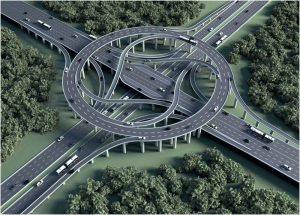Hate them or love them, roundabouts are here to stay, and it’s a certainty that you have encountered them at some point in your life. In fact, there is a very high chance that you drive through a roundabout every day. But what are roundabouts? They are circular junctions or intersections, where road traffic tends to flow in one direction, and whoever arrives at the junction first is given priority. A roundabout is also referred to as a road circle, rotary, rotunda, or traffic circle. Who invented roundabouts and where were they first used?
Roundabouts in the UK
The first roundabout was built in Letchworth Garden City, in Britain in 1907, and was intended to serve as a traffic island where pedestrians could gather shortly before continuing with their journey.  But it is argued that these were not true roundabouts given that they had a very different purpose. With time, though, roundabouts were used to slow vehicle speeds and increase the safety of both motorists and pedestrians. This is because drivers had more time to judge pedestrians and oncoming vehicles. In 1966, the UK passed a law to help guide the construction and use of roundabouts.
But it is argued that these were not true roundabouts given that they had a very different purpose. With time, though, roundabouts were used to slow vehicle speeds and increase the safety of both motorists and pedestrians. This is because drivers had more time to judge pedestrians and oncoming vehicles. In 1966, the UK passed a law to help guide the construction and use of roundabouts.
Resistance from the People
Although the invention of roundabouts triggered a backlash from society, the government made it mandatory for all major roads and intersections to implement the “Priority Rule”, to counter the ever-increasing capacity and overcome safety limitations. The modern roundabouts, also known as the magic roundabouts, came into effect in 1972 in Swindon, Wiltshire, United Kingdom. This roundabout directed traffic in both directions, and was designed by Frank Blackmore. Blackmore had earlier participated in the research and development of the traditional roundabout in the UK.
Roundabouts in the USA
Surprisingly, the modern roundabouts were first used in the United States in the 1990s and, as in the UK, were met with resistance. Eventually, residents gave into the idea after learning the advantages of having the circular intersections.
